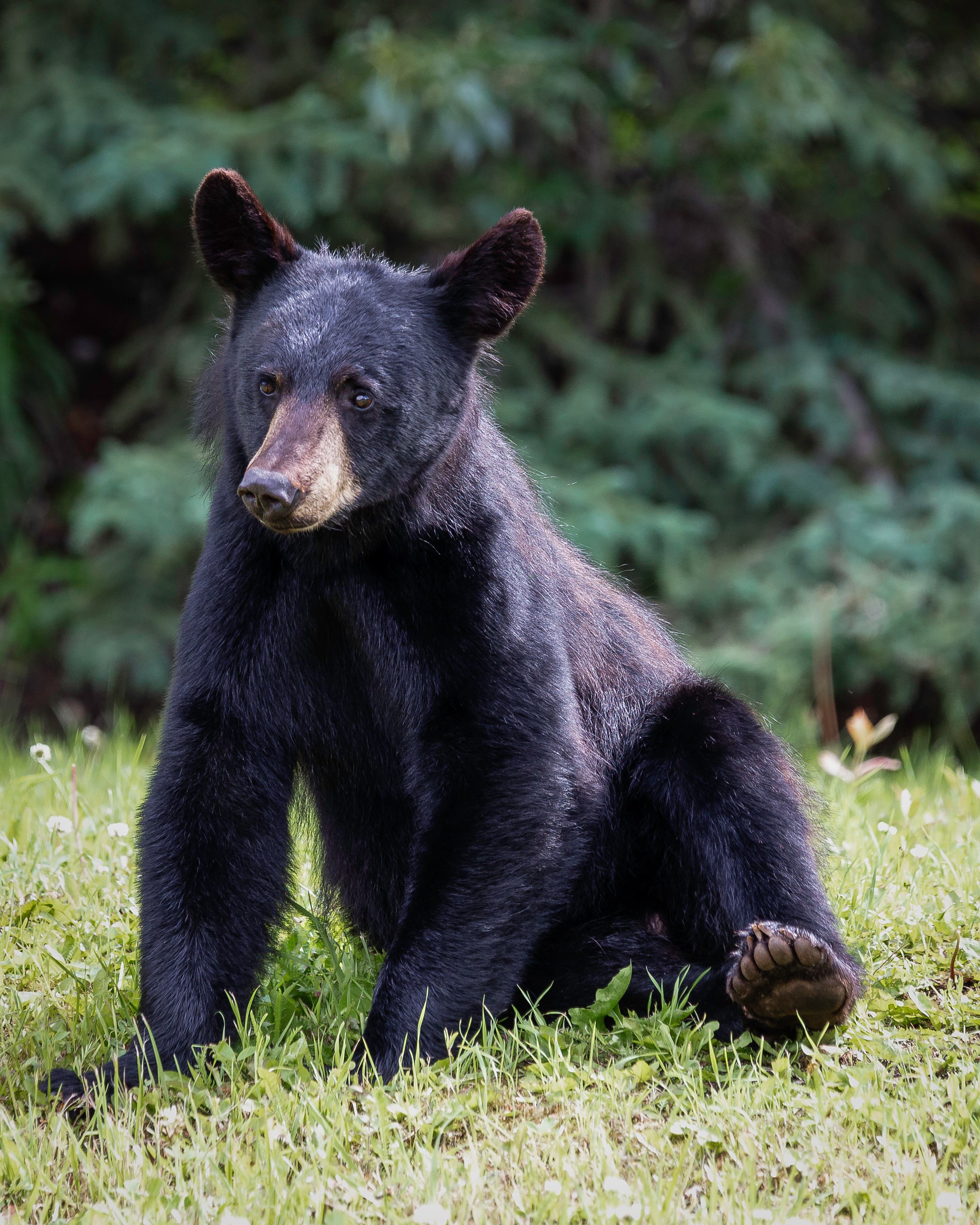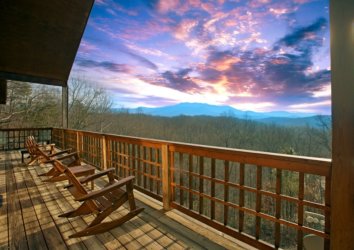There isn’t a better-known four-legged resident of the Great Smoky Mountains than the American black bear. Many parkgoers are eager to see one; some—especially those camping out or hiking—are downright terrified of the prospect. And the Smokies’ bears aren’t by any means confined only to the Great Smoky Mountains National Park itself: It’s not uncommon for them to wander through the outskirts of Gatlinburg—even, periodically, show up on the main drag!
In this article, we’ll break down some of the basics of Smoky Mountain black bears: their ecology, their yearly cycle, and their relationship with people. Right off the bat, we’ll emphasize that black bears are not bloodthirsty monsters and that attacks on people are very rare. When such attacks do happen, very often humans are more to blame than bears…
Introducing the Black Bears of the Great Smokies
Black bears are the third-smallest of North America’s bears, outsized by the polar bear and the brown/grizzly bear. That said, they’re actually the third-biggest bear in the world after those two. While American black bears typically weigh between 150 and 500 pounds, extra-big males (or “boars”) may tip the scales beyond 800 pounds, especially when fully fattened up in the fall.
In the Great Smokies and elsewhere in the Southern Appalachians, black bears are indeed mostly black-colored. But the species as a whole is very variable when it comes to fur color: “Black” bears may be brown, cinnamon, blonde, even (in a couple of specific Northwestern populations) blueish or whitish.
Black bears are the only bears native to the Great Smoky Mountains. Their bigger cousin the grizzly historically didn’t roam far east of the Great Plains. While black bears suffered significant population reduction and range loss with the Euro-American settlement of North America, they were never completely killed off from the Smokies. Today, more than 1,500 black bears are thought to dwell in the park, estimated to host an impressive density of about two bears per square mile.
Black Bear Diet in the Great Smokies
Black bears are classic omnivores. That is, they eat both plants and animals. In the Great Smokies, plant matter—greenery, nuts, fruit (such as berries and wild grapes)—composes by far the majority of a bear’s diet: about 85 percent. Mushrooms can be an important component of their menu as well.
But bears also eagerly seek out invertebrates such as grubs and insects, excavating rotten logs and anthills to get at these energy-packed morsels. They’ll also consume carrion (dead animals), snatch up any rodents they manage to pin down, and occasionally actively hunt white-tailed deer fawns and feral hogs.
One item that shouldn’t be on a Smoky Mountain black bear’s dinner table is human food. Unfortunately, negligent park visitors often leave behind messy picnic areas and campsites that bears readily scrounge through. Some truly irresponsible parkgoers even feed bears, which is strictly against the rules.
The Park Service estimates that black bears, which on a healthy natural diet may live 12 to 15 years, may have a lifespan half that length when feeding heavily on human food and garbage. That may be partly due to poor nutrition, but it certainly can also reflect the greater likelihood that a bear accustomed to scavenging human food or trash—or getting handouts—is more likely to approach people, hang out in developed areas, and quite possibly have to be euthanized due to the potential danger it poses. The phrase “a fed bear is a dead bear” is based on truth.
A Black Bear’s Year
Black bears in the Great Smokies retreat to winter dens in the late fall or early winter. These dens are often in hollow logs, tree roots, or up in the cavities of standing hollow trees. (Big, dying, or dead trees with such cavities used to be common in ancient forests of the Appalachians, and remain abundant in the old-growth of Great Smoky Mountains National Park. In younger woods subjected to heavy logging, such huge, hollow trees are a rarer commodity and bears don’t den off the ground as frequently.)
Black bears don’t enter a true state of hibernation, but rather spend the winter in a deep sleep, waking occasionally and even periodically wandering about outside their dens.
The bear’s den for the winter not because they’re vulnerable to cold, but because the plants and invertebrates forming the foundation of their diet are less available. Bears don’t digest plant matter as efficiently as true herbivores such as deer, which can live off leaner woody browse during the winter. And they’re not effective enough predators to rely on animal prey during the winter months.
Female black bears give birth to anywhere from two to four cubs in their winter dens, typically between late January and early February. Mothers and cubs are usually the last to emerge from their dens in the spring. Most of the Smokies’ black bears are out and about by early April.
In spring, bears seek out greening-up vegetation and insects. In summer, they’re able to start feasting on berries, and in the fall “hard mast”—the nuts of acorns, hickories, and other trees—becomes an extremely important source of nutrition. Bears in fall are focused on fattening up ahead of their winter sleep, and accordingly, they spend more time than ever eating. But bears freshly out of their winter dens in spring are also especially hungry.
Black bears in the Great Smoky Mountains usually mate in July. Cubs stay with their mothers for one and a half years or so.
Black Bear Viewing & Safety
Your average black bear wants nothing to do with people, which, after all, represents the greatest threat to this hefty, brainy omnivore. Black bears in Great Smoky Mountains National Park are used to people and thus may not dash away from an encounter. Most likely, they’ll go about their business foraging or napping, thrilling park visitors who give them room and respect.
You can see black bears anywhere in the Great Smoky Mountains National Park and its surrounding wildlands. Cades Cove is a common place to see bears, particularly in the early morning or evening. If you’re staying in the Gatlinburg area, you may even glimpse a bear around town. (In the spring of 2021, a black bear was seen attacking a feral hog on the outskirts of town in a dramatic sighting.) Garbage in Gatlinburg should be kept secured from bears just as it is in the national park.
If you see a black bear—whether in Gatlinburg or some Smoky Mountain hiking trail or picnic area—don’t approach the animal. Allow it to go about its way. If a bear isn’t budging from its spot, slowly leave the area while backing away or moving sideways while facing the bear. Talk calmly but loudly.
If the bear is clacking its jaws, huffing, swatting the ground, or even bluff-charging, you are definitely too close and stressing it out. Back away calmly but steadily.
If a black bear approaches you, stand your ground, wave your arms, shout, and otherwise look intimidating. In the extremely unlikely event that the bear continues coming toward you—and certainly if the bear attacks—fight back with sticks, stones, or whatever’s available. Don’t play dead! (That’s a strategy appropriate when responding to a defensive grizzly encounter, but generally not for black bears.)
Some people carry bear spray in the national park. The Park Service recommends deploying this highly effective deterrent (which is safe for the bear, though temporarily very irritating) if a bear approaches you within 20 yards without responding to your shouts and arm-waving.
As we’ve already covered, don’t leave food scraps or garbage behind at a picnic area, scenic overlook, or campsite. If you’re camping, keep your food secured in a hard-bodied vehicle—ideally in the trunk—or, if available, in a designated campground food locker. Backpackers should use the provided cable systems to hoist their “bear bags” well off the ground or carry approved bear canisters.
Above all, treat black bears with respect. These are magnificent native creatures that symbolize the wild vitality of the Great Smokies—and unforgettable to see at a safe, responsible distance!




